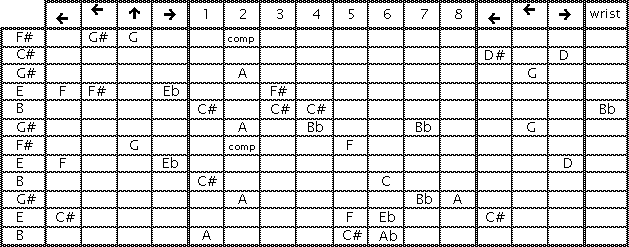Michael Perlowin's Universal Tuning
Editor's note: Michael Perlowin is best known for his classical steel guitar album, Firebird Suite. This astonishing work has turned the steel guitar community on its ear and raised the consciousness of the recording industry at large with regards to the potential of the instrument.
Michael sent me his tuning chart along with a detailed explanation of how it works. To fully appreciate the explanation, you need an understanding of traditional double neck pedal steel tunings (E9th and C6th) and terminology ("A" pedal, Boo Wah, etc.). But even beginners should be able to grasp the significance of some of the innovations here. Print this page and study it carefully - a lot of thought and research went into this tuning.

The Universal Tuning is not the same as a double neck on a single frame. It is a separate tuning, unique unto itself, that contains most of the elements of both tunings, but has both possibilities and limitations not found on a double neck. This particular version of the tuning is designed to bring out the maximum potential of the guitar by incorporating changes that work on both sides of the tuning.
The first thing you see on this tuning are the extra bass strings. By putting changes on these strings, I have bass chords for the A chord (pedals down), C# chord ("A" pedal and R{E-F} knee lever) and C# minor chord ("A" pedal and inner RKL).
Note that I tune my 2nd string to C# and raise it. There are 3 reasons. The first is that many C6th players are now tuning their first string to D. Tuning my second string to C# gives me this. The second is that when going from the E or E7 position (pedals up, 2nd string raised to D natural on the RKR) the release of the the knee lever and lowering of the string from D to C# makes a very nice counterpoint to the raising of the 3rd string from G# to A. The 3rd reason is that when I accidentally hit the 2nd string by mistake it doesn't sound like a clam. Either the note is a chord tone in the A or C# position, or in the E position it's an added 6th.
Some players advocate raising the 9th string up to D to cover the missing D string, and there may be some advantages to having this change, but I lower the 8th instead. By putting this change on the RKR along with raising the second string, I not only have the note, which I use frequently, but I have the "C Pedal" on the B6th if I release my LKR knee lever (E-Eb). The RKR is now a dual pedal, used on both E9 and B6. One of several.
Except for the outer LKL, the rest of my E9 changes are standard. The G# to G change is typically found as an extra floor pedal to the left of the "A" pedal, but this change too works on both the E9 and B6 (with the "B" pedal), so by placing it where I did it is accessible on both the E9 and B6 sides of the tuning.
Pedal number 4, the B6 "D" pedal can also be used on the E9 side. By using it either by itself or with the E9 "C" pedal or any of the left knee levers, a new set of licks can be obtained. Pedal 5, the B6 "B" pedal can now be used with the "D" pedal without taking your right foot off the volume pedal because pedal "C" is conveniently out of the way on the RKR knee lever. Next is the Boo Wah pedal, conveniently located next to its "best friend" and the "A" pedal, tucked out of the way where it doesn't get in the way. The last pedal gives a non-pedal tuning, which I have yet to actually sit down and try to play, but it's there if I want it.
Finally the wrist lever. This is totally cool. Everyone who tries it out wants one. I was skeptical until I tried one out. It took about 2 seconds to make me a believer. The B to Bb change is yet another dual change. This change has so many uses that there is no place to put it, except possibly as a vertical knee lever, where it can be played in all the different situations where it is useful. By putting it on the wrist, it is available no matter what your feet and knees are doing.
This tuning might not be for everybody, but it works for me.
Mike Perlowin
Los Angeles, California
October 1995
| |